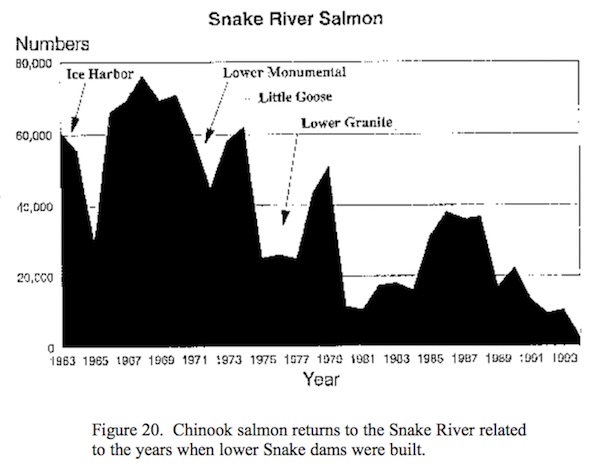forum
library
tutorial
contact

It's About So Much
More Than Fish
by Elizabeth Morgan
Yakima Herald, April 21, 2021
|
the film forum library tutorial contact |

|
It's About So Much
by Elizabeth Morgan
|
 Orofino City Council members were flooded with information regarding the breaching of dams, energy, and fish recovery at their regular meeting held April 13.
Orofino City Council members were flooded with information regarding the breaching of dams, energy, and fish recovery at their regular meeting held April 13.
Bryan Brookes and Kyle Maki with Idaho Wildlife Federation (IWF) provided an update on variables recently introduced to the decades long debate of how to bring salmon and steelhead back to our rivers.
In a PowerPoint presentation, Brookes brought forth a multitude of reasons the organization supports Congressman Simpson's proposal. Fish recovery were at the top of the list.
According to IWF, Idaho wild salmon that must transit the four Lower Snake River (LSR) dams have unsustainable survival rates when compared to the salmon that are only required to go through the Columbia River dams. Salmon on the John Day River in Oregon - which negotiate three dams - have a smolt to adult return (SAR) ratio of around four percent, which is what Snake River salmon need to achieve recovery goals. The mainstream Columbia River Salmon go through four dams and their SAR is also roughly three to four percent. Wild Idaho salmon that transit eight dams (four Columbia and four Snake River) have a SAR of roughly one percent, which biologists say is below replacement and on a trajectory towards extinction.
According to the Federation, over $17 billion has been spent on fish recovery, and there are more endangered salmon species in Idaho than when it began. Congressman Simpson's plan shifts the investment from spending on fish experiments and puts the financial backing for important projects that protect Idaho, according to IWF.
Simpson's proposal asks for $35 billion to address fish recovery, energy, agriculture and transportation.
If dams were to be removed, these benefits must be replaced. It is far too complex to properly share these concepts in this article. The following websites explain in great detail how these concerns are to be rectified.
Related Sites:
The Northwest in Transition Dams: Energy and Salmon, Rep. Mike Simpson
The Northwest in Transition: Myths and Facts, Rep. Mike Simpson
The Columbia Basin Initiative, Rep. Mike Simpson
A Local Perspective
Dr. Dennis Harper was in attendance and responded to the presentation during the public comment portion of the meeting. It is presented now for continuity of the topic.
As an enthusiast for fishing and hunting, with a deep understanding of science and biology, Harper has studied the situation of dams, drawdowns and fish habitat. He makes the following points in the draft of a letter to our Congressmen which gained recent endorsement by the Clearwater County Chamber of Commerce.
Dworshak Dam and the City of Orofino have suffered the brunt of the negative impact and damaging effects, both economically, and recreationally from the Salmon Recovery Program. This goes back to the early 90s, and the economic devastation our community experienced as a result of the drawdowns on Dworshak Reservoir with losses estimated to be nearly $20-40 million dollars annually.
In the discussion of breaching dams, there has not been any proposed mitigation for the loss of flat-water lake recreation or improvement of facilities and infrastructure to offset the impact this action would have. Our economy, our community, and our infrastructure have slowly dwindled.
Loss of recreation on the flatwater at Lewiston will increase our influx of more boaters on Dworshak Reservoir. We are not ready to accommodate and have no facilities to handle this influx, according to Harper.
For the last 30 years, we have watched (and suffered as a result of) poor science running the Salmon Recovery Program. Factual data about netting and overharvesting in the Columbia River along with changing ocean conditions has always been the elephant in the room. Last year the Pacific Ocean experienced its smallest salmon harvest since 1988.
As we know the Hells Canyon complex dams have taken 80% of the usable spawning area from the salmon. Hells Canyon complex has no fish ladders, or temperature regulation systems...Historically, the young salmon fry would turn into smolts and migrate down the river in June.
These salmon now return to the ocean in August, and it is believed the cold water drawn from Dworshak Reservoir is required to facilitate this return...These issues could be corrected with some work, but there has been no change or discussion of improvements in the Hells Canyon complex dams.
In Harper's opinion, if the dams are breached there will be years of sediment to deal with. The impact on all the effected waterways will be significant and the ramifications profound.
If we talk about clean power generation, it's difficult to find a better source of clean, safe, and easy to manage power other than hydropower.
We are currently coping with a massive influx of people to our area, both to live and to recreate. This has strained our limited resources to the breaking point. We lose, economically certainly, and more importantly, all of the things that make Orofino such a wonderful place to live and recreate, reported Harper.
learn more on topics covered in the film
see the video
read the script
learn the songs
discussion forum
